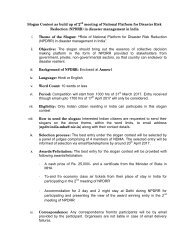National Disaster Management Guidelines School Safety Policy
School-Safety-Policy
School-Safety-Policy
You also want an ePaper? Increase the reach of your titles
YUMPU automatically turns print PDFs into web optimized ePapers that Google loves.
SCHOOL <strong>Safety</strong><br />
POLICY <strong>Guidelines</strong><br />
For First Aid and Site Security team the representative of nearest Police Station, Hospital/ health<br />
services and fire station may be identified. The roles and responsibilities of these committees during<br />
disaster as well as peace time need to be defined clearly.<br />
c. Resouce inventory<br />
i. Listing of resources available inside the school campus: which could be used during any<br />
disaster situation for effective response.<br />
ii. Identification and listing of resources outside the school within vicinity of one-five kilometres<br />
a Nearest hospitals Health Centre for emergency treatment.<br />
b. Police Station<br />
c. Fire Station<br />
iii. Updation of important telephone numbers in Principal's room<br />
iv Critical health problem record of each child to be maintained by school and also<br />
displayed on his I-Card with blood group along with Updated contact details of parents/<br />
Guardian and alternate contact persons.<br />
v. <strong>Disaster</strong> preparedness check-list. (Attached in Annexure 8 (ii)<br />
d. Mechanism for alerting students and teachers during school time including installation<br />
of alarm.<br />
e. <strong>School</strong> Map with evacuation plan in place (Attached in Annexure 8 (iii).<br />
f. Annual calendar for conducting various preparedness activities along with plan to<br />
implement it. This will include the list of various awareness generation programmes to be<br />
conducted by the school annually.<br />
g. Action plan for conducting Mock drills and development of a checklist to identify the gaps<br />
h. Steps for Updation of DM plan - indicating the time line and the process of doing it along with<br />
the roles of teachers and other non teaching staff.<br />
Guiding notes for Resource inventory:<br />
As part of preparedness exercise, each school must develop a <strong>School</strong> DM kit. It is suggested that a<br />
network is established by the school management with the nearest hospital/ health centre/ health<br />
worker for help in case of emergency. The suggestive list of items which could be procured for school<br />
DM kit have been listed below. However, it is suggested that each school must have provision for other<br />
external resources (grants given by the State Government like MPLADs/ MLALADs etc.) to strengthen<br />
this resource list further.<br />
i. Stretcher<br />
}<br />
ii. Ladders<br />
iii. Thick rope<br />
iv. Torch<br />
Provision of <strong>School</strong> DM kit.<br />
v. First-aid box<br />
vi. Temporary shelter (tents and tarpaulins)<br />
vii. Sand buckets<br />
viii. Fire Extinguishers<br />
<strong>School</strong> map with evacuation plan:<br />
Annexure<br />
It is recommended to prepare a floor wise evacuation plan and display it prominently at the notice<br />
board on each of the floors. The evacuation plan may be discussed by the evacuation team with the<br />
teachers and students to generate awareness to help conduct mock drill. (A sample Evacuation Map is<br />
attached for reference as Annexure 8 (iii)<br />
Guiding note for Mock drill<br />
Mock drills are the ways of rehearsing the preparedness plan. It is one of the last steps in preparedness.<br />
The mock drill on earthquake, fire etc. may conducted at periodic interval preferably once in every<br />
47



